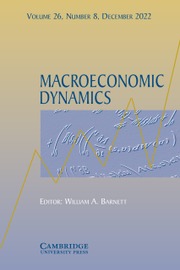No CrossRef data available.
Article contents
A Schumpeterian exploration of Gini and top/bottom income shares
Published online by Cambridge University Press: 21 October 2024
Abstract
Data show that an increase in the Gini coefficient is associated with a falling bottom  $p_{B}$% income share and an increasing top
$p_{B}$% income share and an increasing top  $p_{T}$ % income share where, for example
$p_{T}$ % income share where, for example  $p_{B}$ = 40 and
$p_{B}$ = 40 and  $p_{T}$ = 1. This relationship, which we call the
$p_{T}$ = 1. This relationship, which we call the  $X$ inequality relationship, is pervasive in the sense that it is observed in many countries, including the US, the UK, France and others. The purpose of this paper is (i) to construct a Schumpeterian growth model to explain the relationship, and (ii) to identify/quantify factors behind it via calibration of the US economy. Our model gives rise to a double-Pareto distribution of income as a result of entrant and incumbent innovations. Its advantage is that it allows us to develop iso-Gini loci and iso-income share schedules in a tractable way. Using a double-Pareto distribution as an approximation of an underlying income distribution, calibration analysis reveals that a declining business dynamism and fiscal policy changes in the past decades played a significant role in generating the
$X$ inequality relationship, is pervasive in the sense that it is observed in many countries, including the US, the UK, France and others. The purpose of this paper is (i) to construct a Schumpeterian growth model to explain the relationship, and (ii) to identify/quantify factors behind it via calibration of the US economy. Our model gives rise to a double-Pareto distribution of income as a result of entrant and incumbent innovations. Its advantage is that it allows us to develop iso-Gini loci and iso-income share schedules in a tractable way. Using a double-Pareto distribution as an approximation of an underlying income distribution, calibration analysis reveals that a declining business dynamism and fiscal policy changes in the past decades played a significant role in generating the  $X$ inequality relationship in the US.
$X$ inequality relationship in the US.
- Type
- Articles
- Information
- Copyright
- © The Author(s), 2024. Published by Cambridge University Press


